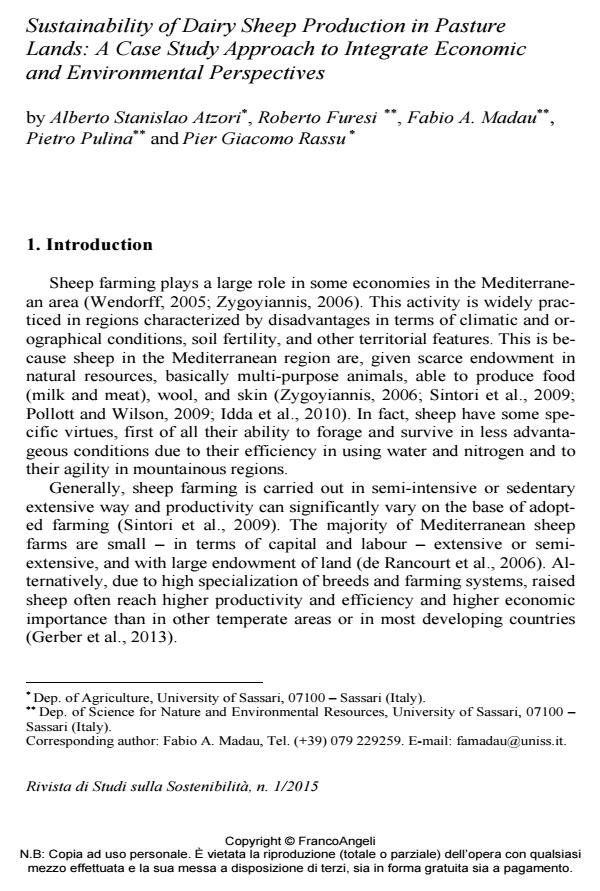Sustainability of Dairy Sheep Production in Pasture Lands: A Case Study Approach to Integrate Economic and Environmental Perspectives
Titolo Rivista RIVISTA DI STUDI SULLA SOSTENIBILITA'
Autori/Curatori Alberto Stanislao Atzori, Roberto Furesi, Fabio A. Madau, Pietro Pulina, Pier Giacomo Rassu
Anno di pubblicazione 2015 Fascicolo 2015/1
Lingua Inglese Numero pagine 18 P. 117-134 Dimensione file 242 KB
DOI 10.3280/RISS2015-001008
Il DOI è il codice a barre della proprietà intellettuale: per saperne di più
clicca qui
Qui sotto puoi vedere in anteprima la prima pagina di questo articolo.
Se questo articolo ti interessa, lo puoi acquistare (e scaricare in formato pdf) seguendo le facili indicazioni per acquistare il download credit. Acquista Download Credits per scaricare questo Articolo in formato PDF

FrancoAngeli è membro della Publishers International Linking Association, Inc (PILA)associazione indipendente e non profit per facilitare (attraverso i servizi tecnologici implementati da CrossRef.org) l’accesso degli studiosi ai contenuti digitali nelle pubblicazioni professionali e scientifiche
Sheep farming plays a large role in some specific economies, maintains strong links with natural resources, and produces multiple functions in rural areas. Its sustainability has to deal with different purposes. This study aims to assess economic and environmental sustainability of extensive dairy sheep farming in Sardinia. A case study approach was adopted in order to directly collect farm data and to integrate assessments on more dimensions of sustainability. We found that farm is not profitable without support of public financial aids. Furthermore, production of nitrogen is under the normative limit and greenhouses gas emission intensity, allocated with economic criteria, was equal to 2,3 and 16,1 kg of CO2eq emitted per kg of produced milk and meat, respectively. Empirical evidences suggest the need to better take into account environmental externalities and into the farmer’s choices. A public financial support system expressively based on minimizing environmental externalities might force farmers to incentive eco-sustainable production and guarantee them profitability.
L’allevamento ovino riveste un’importanza strategica in molte realtà, in quanto è connesso all’uso delle risorse naturali ed espleta una molteplicità di funzioni nei territori rurali. Ciò implica che la sostenibilità delle pratiche deve tenere conto della dimensione multifunzionale. Il presente studio è volto a valutare la sostenibilità economica ed ambientale dell’allevamento ovino estensivo in Sardegna. Al fine di poter basare la valutazione su dati direttamente rilevati in azienda, si è optato per un caso studio. Questo approccio ha consentito di poter meglio integrare le valutazioni sul piano economico ed ambientale. È stato valutato che l’impresa in oggetto risulta in attivo solo grazie all’entità dei contributi pubblici. Sul fronte ambientale, la produzione di azoto è inferiore al limite consentito per legge e l’emissione di gas serra è pari rispettivamente a 2,3 e 16,1 Kg di CO2 equivalente per Kg di latte e carne. Si evince l’importanza di tener conto degli effetti ambientali in fase decisionale e che un sistema di incentivi economici ancorato all’obiettivo di minimizzare tali effetti potrebbe stimolare gli allevatori a produzioni eco-sostenibili e, nel contempo, remunerative.
Parole chiave:Allevamento ovino, balance sheet analysis, analisi del ciclo di vita, risorse naturali, multifunzionalità, politiche agricole
- Review of environmental performance of sheep farming using life cycle assessment Akul Bhatt, Bassim Abbassi, in Journal of Cleaner Production 126192/2021 pp.126192
DOI: 10.1016/j.jclepro.2021.126192 - The sustainability of small‐scale sheep and goat farming in a semi‐arid Mediterranean environment Giuseppe Timpanaro, Vera Teresa Foti, in Journal of Sustainable Agriculture and Environment e12111/2024
DOI: 10.1002/sae2.12111 - Dietary strategies of feral and domestic horses under varying grazing pressures: insights for Mediterranean forest management Araceli Gort-Esteve, Jordi Bartolomé Filella, Xènia Roselló Molinero, Ada Torra Burgués, Joan Lluís Riera, Ariadna Nieto-Espinet, in Agroforestry Systems 208/2025
DOI: 10.1007/s10457-025-01291-9 - Economic performance of agritourism: an analysis of farms located in a less favoured area in Italy Brunella Arru, Roberto Furesi, Fabio A. Madau, Pietro Pulina, in Agricultural and Food Economics 27/2021
DOI: 10.1186/s40100-021-00199-z - Life cycle impacts of sheep sector in Ontario, Canada Akul Bhatt, Bassim Abbassi, in The International Journal of Life Cycle Assessment /2022 pp.1283
DOI: 10.1007/s11367-022-02105-1 - Key practices affecting the environmental impact of Ewe milk in mixed farming systems Matteo Finocchi, Fabrizio Giuseppe Cella, Ricardo Villani, Alice Cappucci, Francesca Vichi, Giuseppe Conte, Alberto Mantino, Marcello Mele, in Cleaner Environmental Systems 100353/2025 pp.100353
DOI: 10.1016/j.cesys.2025.100353
Alberto Stanislao Atzori, Roberto Furesi, Fabio A. Madau, Pietro Pulina, Pier Giacomo Rassu, Sustainability of Dairy Sheep Production in Pasture Lands: A Case Study Approach to Integrate Economic and Environmental Perspectives in "RIVISTA DI STUDI SULLA SOSTENIBILITA'" 1/2015, pp 117-134, DOI: 10.3280/RISS2015-001008